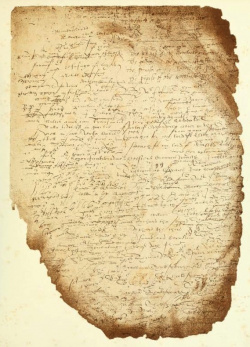Asmund and Cornelia
Historical Records
Alnwick Castle, MS 525
The title appears twice on the cover page of a badly damaged folio volume held at Alnwick Castle (MS 525, fol. 1r). While the page appears to be a welter of words, letters, and scribbles, it seems to have originally listed the contents of the volume, since the first entries in the list are represented in the portion of the volume that survives. The title "Asmund and Cornelia" appears in a series of play titles, apparently written in the same hand as the contents: these works are no longer represented in the surviving manuscript, but may have been originally included in the volume.
- William Shakespeare
- Rychard the second
- Rychard the third
- Asmund and Cornelia
- Ile of doges frmnt
- by Thomas Nashe [&] inferior plaiers
The title appears again in a different hand (although possibly by the same scribe) to the left of this list. (See image below.)
Several facsimiles and transcriptions of the page have been published (see esp. Burgoyne xviii-xix, [pp. 168-71]). A high-resolution photograph is available through Shakespeare Documented here.

|

|
| Alnwick Castle, MS 525, fol. 1r | Detail of Alnwick Castle, MS 525, fol. 1r |
(Out of copyright photograph of the Alnwick Castle MS from James Spedding, ed., A Conference of Pleasure by Francis Bacon [London, 1870]. Internet Archive).
Theatrical Provenance
Unknown. See Critical Commentary below.
Probable Genre(s)
Unknown. See For What It's Worth below.
Possible Narrative and Dramatic Sources or Analogues
See For What It's Worth below.
References to the Play
None known.
Critical Commentary
Hazlitt (17) commented: "I take this to be a misreading for Gismund and Cornelia, and to refer to two distinct productions—Tancred and Gismunda, 1591; and Kyd's Cornelia, a translation from Garnier."
Burgoyne (xiii) comments: "Probably a play, but nothing is known respecting it."
Wiggins (#1034) suggests a date of 1596 on the basis of the contents of the MS, especially the other dramatic compositions listed, which date from 1593, 1595, and 1597, respectively. He also notes that a scribe has scribbled a line of poetry near the list ("Revealing day through every cranny peeps"), which closely resembles a line from The Rape of Lucrece (l. 1086). "It is possible that the line derives from the play (or perhaps from The Isle of Dogs […], which is listed immediately afterwards), and that the annotator had spotted the debt to Shakespeare's poem."
For What It's Worth
Asmund and Gumnilda?
While it seems clear that the scribe copied the title "Asmund and Cornelia" it may be that this transcription has obscured the original narrative source of the play. One possibility might be the story of Asmund (Asmundus) and Gunhild (Gunnilda) that appears in the Gesta Danorum of Saxo Grammaticus. In Saxo, Asmund falls in battle avenging the death of his father Swipdag.
- Asmund's body was buried in solemn state at Upsala and attended with royal obsequies. His wife Gunnhild, loth to outlive him, cut off her own life with the sword, choosing rather to follow her lord in death than to forsake him by living. Her friends, in consigning her body to burial, laid her with her husband's dust, thinking her worthy to share the mound of the man, her love for whom she had set above life. So there lies Gunnhild, clasping her lord somewhat more beautifully in the tomb than she had ever done in the bed.
- (Elton, trans., 33; cf. Friis-Jensen 54–57)
Saxo was, of course, a narrative source for Hamlet, and the story of Asmund and Gunhild was related by Francis Meres in 1598:
- As Portia the daughter of Cato, hearing of her Brutus death at Philippi swallowed hot burning coales to followe him, as Plutarke, Ualerius Maximus, and Martiall doe write: so Gumnilda the wife of Asmunda King of Danes, hearing that her husbande was slaine in the wars, slew her selfe with a sword, to accompany him in death, whome she had dearelie loued in life, as testifieth Saxo Grammaticus, in his first booke of the Danish historie.
- (Meres fol. 47v)
Did the dramatist adapt the Danish chronicle story, changing the name of his hero's wife? Did the scribe of the Northumberland MS mistranscribe the unfamiliar name when the title was copied on fol. 1?
Works Cited
Site created and maintained by Misha Teramura, University of Toronto; updated 9 March 2016.